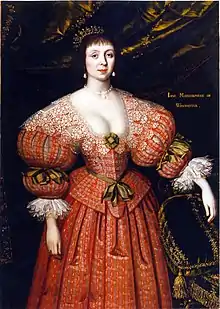
Jane Paulet née Savage, Marchioness of Winchester (1608–1631) was an English aristocrat, and her death was the subject of several poems.
She was a daughter of Thomas Savage, 1st Viscount Savage of Rocksavage and Elizabeth Darcy.
She married John Paulet, 5th Marquess of Winchester in 1623. Her surviving child Charles Paulet, 1st Duke of Bolton was born in 1629.[1]

James Howell claimed to have taught her Spanish, and 1626 translated a sonnet for her into Spanish, in the same metre so that it could be sung to the same tune.[2]
She died during childbirth on 15 April 1631 at Basing House.[3] She had an "imposthume", an infected swelling of the mouth and cheek which had developed from a toothache, which caused a fever. Her child was stillborn during an intervention for the infection.[4] The circumstances of her death at Easter time in the presence of house guests including her grandfather Lord Rivers and her three sisters were noted in letters written by the Duchess of Buckingham, the Countess of Westmorland, and John Pory.[5]
John Pory included a brief account of her death in a letter to Thomas Puckering, "The Lady Marquess of Winchester, daughter to the Lord Viscount Savage, had an impostume upon her cheek lanced; the humour fell down into her throat, and quickly dispatched her, being big with child, whose death is lamented as well in respect of other her virtues, as that she was inclining to become a protestant".[6]
John Milton, Ben Jonson, Walter Colman, and others wrote epitaphs.[7]
Two portraits of Jane Paulet survive, by Gilbert Jackson, dated 1627 and 1632.
References
- ↑ Lyn Boothman, Richard Hyde Parker, David Percy Dymond, Savage Fortune: An Aristocratic Family in the Early Seventeenth Century (Boydell, 2006), pp. xxxv, xlvi.
- ↑ James Howell, Epistolae Ho-elianae, familiar letters (London,1650), p. 116.
- ↑ Lyn Boothman, Richard Hyde Parker, David Percy Dymond, Savage Fortune: An Aristocratic Family in the Early Seventeenth Century (Boydell, 2006), p. xlvii.
- ↑ Louis Schwartz, 'Scarce-well-lighted Flame: Milton's "Epitaph on the Marchioness of Winchester" and the Representation of Maternal Mortality in the Seventeenth-Century Epitaph', Charles Durham & Kristin Pruitt, All in All: Unity, Diversity, and the Miltonic Perspective (Susquehanna University Press, 1999), p. 201.
- ↑ HMC Rutland, vol. 1 (London, 1888), p. 490: Court and times of Charles I, vol. 2 (London. 1848), p. 106: NRAS 217 Moray papers, 5:297.
- ↑ Thomas Birch & Robert Folkestone Williams, Court and times of Charles I, vol. 2 (London. 1848), p. 106
- ↑ Louis Schwartz, 'Tears of perfect moan: Milton and the Marchioness of Winchester', Milton and Maternal Mortality (Cambridge, 2009), p. 91: Lyn Boothman, Richard Hyde Parker, David Percy Dymond, Savage Fortune: An Aristocratic Family in the Early Seventeenth Century (Boydell, 2006), pp. xlvii-xlviii: Walter Colman, La danse machabre, or death's duell (n. pl., ?1631).